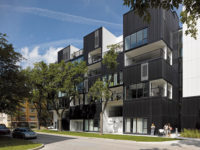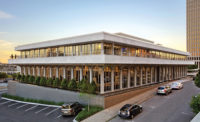On the main thoroughfare through the commercial district of Winnipeg, Manitoba, a series of metal boxes protrudes from the 1904 facade of the Avenue Building like a cluster of Donald Judd sculptures bursting from the windows. Shimmering in the purple-gray light and ambient snow of the winter sky, the mirrored rectangles set the building apart from the Neoclassical facades and modern corporate buildings that line Portage Avenue. "It was important in our context for the architecture to have a presence on the street," says Johanna Hurme, a principal of 5468796 Architecture, the young firm with a difficult-to-remember name that converted the former office building. "We had to show that there is a new act for the old body."
Additional Content:
Jump to credits & specifications
The six-story, timber-and-steel-framed Avenue Building housed offices above street-level retail space for much of its life. But suburbanized Winnipeg has long had a surplus of downtown commercial space, and after its last occupants moved out, the building sat abandoned and blighted for nearly 16 years. The city took steps to clean up the pigeon-infested edifice several years ago, but was unable to find a buyer until Mark and Rick Hofer came along.
The brothers bought the property and came up with a plan to turn the Avenue and its smaller three-story neighbor, built in 1906, into rental apartments, relying on a short timeline, a tight budget, and a cavalier attitude to make the venture profitable. "They're cowboys," says 5468796 architect Zach Pauls. The firm (featured in RECORD's Design Vanguard, December 2011) had recently worked with the duo to convert a century-old warehouse into a residential building, and the developers hired them again for the Avenue project with Rick Hofer's building company serving as contractor. In just under two years, the architects navigated emergent challenges and made on-the-fly design changes to transform the derelict buildings into an in-demand residential address and a signifier of a rejuvenated neighborhood.
Twenty of the project's 75 units have the prominent metal balconies, which extend 5 to 9 feet beyond the larger building's south elevation. The firm preserved the original masonry facade and window dimensions, mounting the balconies on posts attached to the existing floor. The steel-framed boxes get additional support from cross braces on each of their long sides, which the firm hid under mirror-polished, 1.8-inch-thick aluminum cladding. "We did studies with loud colors and different finishes," says project architect Colin Neufeld. "But in the end, we went with something quieter that still has a strong presence." The architects used steel grating for the balcony floors to prevent snow accumulation, which creates slightly vertiginous views down to the street.
The apartment interiors suffer from the owner also serving as the contractor. While the designers planned the units, taking advantage of the building's high ceilings to make the 430- to 1,020-square-foot layouts feel spacious, the clients finished the spaces with clunky materials and tacky Pop colors that give the interiors the down-market look of student apartments. "You have to pick your battles," says Hurme. "What mattered most to us was the public face and maximizing the small space of the units."
The owner's dual role did help the project clear its biggest hurdle. Halfway through construction, Manitoba Start, a nonprofit organization that provides services for recent immigrants, agreed to a 15-year lease on the ground-floor storefront-great news in a tough commercial market. But the prospective tenant needed double the amount of space available in the original plan. The firm determined that it could convert the upper stories of the smaller building-originally slated to be apartments-into commercial space and combine them with the storefront to provide the needed space. But the project's financing was contingent on $2 million in city and provincial grants based on exactly 75 residential units; eliminating a few was not an option.
The architects decided to make up for the lost residential space with an addition on top of the shorter building, but they ran into another problem. The city would not permit the structure's poured-in-place concrete frame to support additional stories. Instead, the firm floated two new floors in an independent steel structure above the building, raising it on columns that extend down through the original structure and anchor below its foundation. The owner-contractor built the addition quickly, adding the necessary apartments and accommodating the tenant while sticking close to the construction schedule. With Manitoba Start on board, the architects designed a striking interior for the nonprofit, opening a three-story atrium in the center of the smaller building and organizing classroom and support spaces in a series of boxes.
An angular canopy clad in the same aluminum as the balconies juts out from above the Manitoba Start storefront. Reflecting pedestrian traffic and the activity inside, it brings energy to the sidewalk in a city not known for its street life (the average low temperature in winter hovers around -4 Fahrenheit). Up on the balconies, residents have a rooted connection to the avenue below, a connection more like the semipublic space of a cast-iron New Orleans gallery or a classic fire escape than a private terrace. To passersby, the project's surprising form signals that something is happening on the Winnipeg street-even in the frozen winter.
Completion Date: July, 2012
Gross square footage: 73,000 Square Feet
Total construction cost: $12.5 million
CreditsOwner: Edgecorp Group
Architect: 5468796 Architecture Inc. Personnel in architect's firm who should receive special credit: Sharon Ackerman, Designer
Interior designer: 5468796 completed all design
Engineer(s): Structural: Lavergne Draward & Associates Mechanical: G.d. Stasynec & Associates
General contractor: Hofer Construction Ltd.
Photographer(s): James Brittain Photography 5468796 Architecture
Renderer(s): 5468796 Architecture CAD system, project management, or other software used: Vectorworks |
SpecificationsStructural system Existing Loadbearing Masonry, Wood, Concrete And Steel. Wood Joists And Concrete Work ByHofer Construction Ltd. Manufacturer of any structural components unique to this project:
Exterior cladding Metal Panels: Vicwest Curtain wall:Alumicor Other cladding unique to this project: (mirrored finish aluminum) Central Prairie Products
Roofing Other: Urecoat UC-540 Aluminum Polymer Coating
Windows Jeldwen windows and doors - PVC
Doors Allmar Distributors And Penner Doors And Windows
Hardware Locksets: Schlage Closers: LCN Exit devices: LCN Pulls: Custom
Interior finishes Cabinetwork and custom woodwork: Springfield Woodworking Solid surfacing: Granite Floor and wall tile: Eurotile (entrance lobby and all kitchen & baths)
Furnishings Eq3 Furniture Used In Show Suites
Lighting Custom Corridor Lighting By:
Conveyance Elevators/Escalators: Kone |












Post a comment to this article
Report Abusive Comment